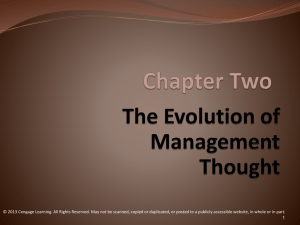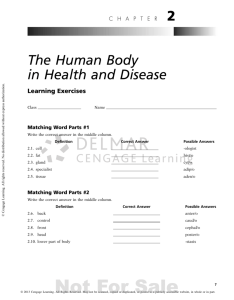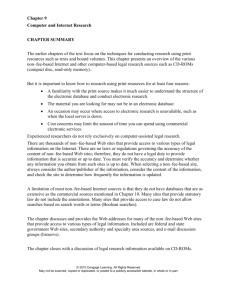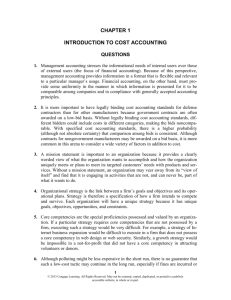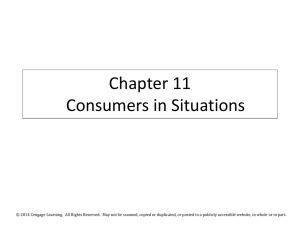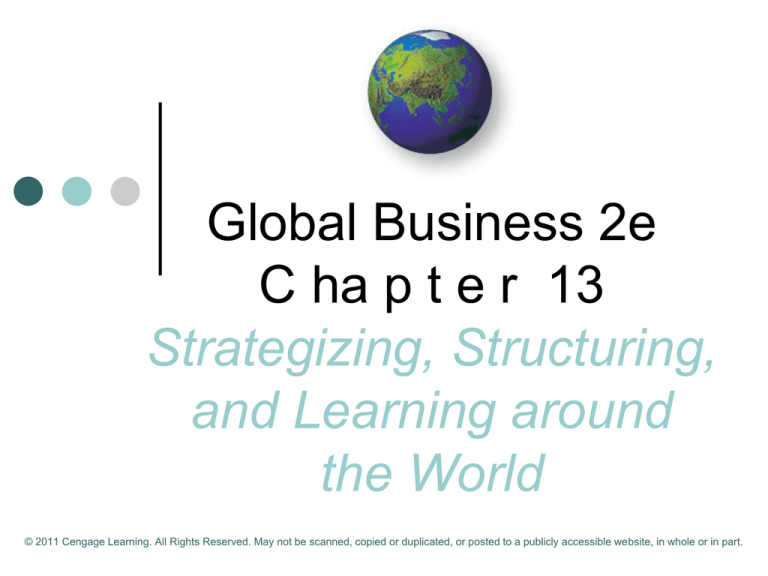
Global Business 2e
C ha p t e r 13
Strategizing, Structuring,
and Learning around
the World
© 2011 Cengage Learning. All Rights Reserved. May not be scanned, copied or duplicated, or posted to a publicly accessible website, in whole or in part.
LEARNING OBJECTIVES
After studying this chapter, you should be able to:
1. Describe the relationship between multinational strategy and
structure.
2. Explain how institutions and resources affect strategy,
structure, and learning.
3. Outline the challenges associated with learning, innovation,
and knowledge management.
4. Participate in two leading debates on multinational strategy,
structure, and learning.
5. Draw implications for action.
© 2011 Cengage Learning. All Rights Reserved. May not be scanned, copied or duplicated, or posted to a publicly accessible website, in whole or in part.
MULTINATIONAL STRATEGIES
AND STRUCTURES
Pressures for Cost Reductions
and Local Responsiveness
Integration-responsiveness framework
Allows managers to deal with the
pressures for both global integration and
local responsiveness
Local responsiveness
Necessity to be responsive to different
customer preferences around the world
© 2011 Cengage Learning. All Rights Reserved. May not be scanned, copied or duplicated, or posted to a publicly accessible website, in whole or in part.
FOUR STRATEGIC
CHOICES
Home replication strategy
Duplicates home country-based competencies in
foreign countries
Localization (multidomestic) strategy
Focuses on a number of foreign countries/regions,
each of which is regarded as a stand-alone local
(domestic) market worthy of significant attention
and adaptation
© 2011 Cengage Learning. All Rights Reserved. May not be scanned, copied or duplicated, or posted to a publicly accessible website, in whole or in part.
FOUR STRATEGIC
CHOICES
Global standardization strategy
Development and distribution of standardized products
worldwide in order to reap the maximum benefits from
low cost advantages
Center of excellence
Subsidiary explicitly recognized as a source of important
capabilities, with the intention that these capabilities be
leveraged by and/or disseminated to other subsidiaries
Worldwide (global) mandate
Responsible for one MNE function throughout
the world
© 2011 Cengage Learning. All Rights Reserved. May not be scanned, copied or duplicated, or posted to a publicly accessible website, in whole or in part.
FOUR STRATEGIC
CHOICES
Transnational strategy
Aims to capture the best of both worlds by
endeavoring to be both cost efficient and
locally responsive
© 2011 Cengage Learning. All Rights Reserved. May not be scanned, copied or duplicated, or posted to a publicly accessible website, in whole or in part.
© 2011 Cengage Learning. All Rights Reserved. May not be scanned, copied or duplicated, or posted to a publicly accessible website, in whole or in part.
© 2011 Cengage Learning. All Rights Reserved. May not be scanned, copied or duplicated, or posted to a publicly accessible website, in whole or in part.
© 2011 Cengage Learning. All Rights Reserved. May not be scanned, copied or duplicated, or posted to a publicly accessible website, in whole or in part.
A RECIPROCAL
RELATIONSHIP
• Strategy usually drives structure
• As much as strategy drives structure,
structure also drives strategy
• Neither strategies nor structures are
static
• It is often necessary to change strategy,
structure, or both
© 2011 Cengage Learning. All Rights Reserved. May not be scanned, copied or duplicated, or posted to a publicly accessible website, in whole or in part.
© 2011 Cengage Learning. All Rights Reserved. May not be scanned, copied or duplicated, or posted to a publicly accessible website, in whole or in part.
INSTITUTION-BASED
CONSIDERATIONS
Externally, MNEs are subject to the formal
institutional frameworks erected by various
home-country and host-country
governments
Host-country governments often attract,
encourage, or coerce MNEs into
undertaking activities that they otherwise
would not
© 2011 Cengage Learning. All Rights Reserved. May not be scanned, copied or duplicated, or posted to a publicly accessible website, in whole or in part.
INSTITUTION-BASED
CONSIDERATIONS
Dealing with host countries also involves
numerous informal institutions
Airbus devotes 40% of its procurement budget to
US suppliers in more than 40 states but there is
no formal requirement to farm out supply
contracts
Its sourcing decisions are guided an informal
norm of reciprocity: If one country’s suppliers are
involved with Airbus, airlines based in that
country are more likely to buy Airbus aircraft
© 2011 Cengage Learning. All Rights Reserved. May not be scanned, copied or duplicated, or posted to a publicly accessible website, in whole or in part.
INSTITUTION-BASED
CONSIDERATIONS
Formal organizational charts do not reveal are the informal
rules of the game, such as organizational norms, values,
and networks
The nationality of the head of foreign subsidiaries is such
an example:
• a home country national as the head of a subsidiary (such
as an American for a subsidiary of a US-headquartered MNE
in India)
• a host country national (such as an Indian for the same
subsidiary)
• a third-country national (such as an Australian for the same
subsidiary above)
The nationality of top executives at the highest level (such
as chairman, CEO, and board members) seems to follow
another informal rule: they are almost always home-country
nationals.
© 2011 Cengage Learning. All Rights Reserved. May not be scanned, copied or duplicated, or posted to a publicly accessible website, in whole or in part.
RESOURCE-BASED
CONSIDERATIONS
When looking at structural changes, it is critical to
consider whether a new structure (such as a matrix)
adds concrete value.
The value of innovation must also be considered as
a vast majority of innovations simply fail to reach
market, and most new products that do reach
market end up being financial failures
© 2011 Cengage Learning. All Rights Reserved. May not be scanned, copied or duplicated, or posted to a publicly accessible website, in whole or in part.
RESOURCE-BASED
CONSIDERATIONS
A second question is rarity
Certain strategies or structures may be in
vogue at a given point in time but they are
designed to be implemented widely and
appeal to a broad range of firms, thus
providing no firm-specific advantage for
the adopting firm
© 2011 Cengage Learning. All Rights Reserved. May not be scanned, copied or duplicated, or posted to a publicly accessible website, in whole or in part.
RESOURCE-BASED
CONSIDERATIONS
Even when capabilities are valuable and rare, they
have to pass a third hurdle, namely, imitability
Formal structures are easier to observe and imitate
than informal structures
The informal, flexible matrix is less a structural
classification than a broad organizational concept
or philosophy, manifested in organizational
capability and management mentality
© 2011 Cengage Learning. All Rights Reserved. May not be scanned, copied or duplicated, or posted to a publicly accessible website, in whole or in part.
RESOURCE-BASED
CONSIDERATIONS
Organizational culture
Collective programming of the mind that
distinguishes the members of one
organization from another
? Can you think of an example of organizational
culture in your personal life?
© 2011 Cengage Learning. All Rights Reserved. May not be scanned, copied or duplicated, or posted to a publicly accessible website, in whole or in part.
KNOWLEDGE MANAGEMENT
Knowledge management
Structures, processes, and systems that actively
develop, leverage, and transfer knowledge.
Explicit knowledge
Knowledge that is codifiable (that is, can be
written down and transferred with little loss of
richness).
Tacit knowledge
Knowledge that is noncodifiable, and its
acquisition and transfer require hands-on
practice.
© 2011 Cengage Learning. All Rights Reserved. May not be scanned, copied or duplicated, or posted to a publicly accessible website, in whole or in part.
© 2011 Cengage Learning. All Rights Reserved. May not be scanned, copied or duplicated, or posted to a publicly accessible website, in whole or in part.
PROBLEMS AND SOLUTIONS IN
KNOWLEDGE MANAGEMENT
Global virtual team
Teams that do not meet face to face
Absorptive capacity
The ability to recognize the value of new
information, assimilate it, and apply it
Social capital
The informal benefits individuals and organizations
derive from their social structures and networks
Micro-macro link
The micro, informal interpersonal relationships
among managers of various units may greatly
facilitate macro, inter-subsidiary cooperation
© 2011 Cengage Learning. All Rights Reserved. May not be scanned, copied or duplicated, or posted to a publicly accessible website, in whole or in part.
© 2011 Cengage Learning. All Rights Reserved. May not be scanned, copied or duplicated, or posted to a publicly accessible website, in whole or in part.
CORPORATE CONTROLS VS
SUBSIDIARY INITIATIVES
Subsidiary initiative
When subsidiaries actively pursue their
own, subsidiary level strategies and
agendas
© 2011 Cengage Learning. All Rights Reserved. May not be scanned, copied or duplicated, or posted to a publicly accessible website, in whole or in part.
CUSTOMER-FOCUSED DIMENSIONS
VS INTEGRATION,
RESPONSIVENESS AND LEARNING
Global account structure
Customer-focused dimension in which
companies strive to supply customers (often
other MNEs) in a coordinated and consistent
way across various countries
Solutions-based structure
Customer-focused dimension in which
companies strive to supply customers with what
fits their needs, regardless of what that involves
© 2011 Cengage Learning. All Rights Reserved. May not be scanned, copied or duplicated, or posted to a publicly accessible website, in whole or in part.
© 2011 Cengage Learning. All Rights Reserved. May not be scanned, copied or duplicated, or posted to a publicly accessible website, in whole or in part.



